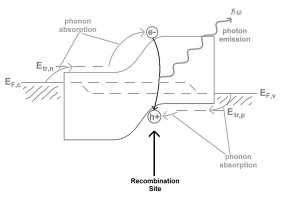Bounds on Energy-efficient Optical Communication

Figure 1: Band diagram of an LED operating at low bias. While each emitted photon contains more energy than the Fermi-level separation, phonons are absorbed by the electrons and holes prior to recombination. As a result, the electrons in the LED act as the working fluid in a heat engine, transporting energy and entropy from the phonon bath to the photons.
While most classical photonic communication systems expend more than a photon’s worth of energy per bit communicated, the physical limits of efficient communication do not require this much energy. To address this problem, we divide the final measure of energy efficiency into measures describing the efficiency of two processes: photon generation, whose efficiency bounds are set by thermodynamics, and decoding of the received signal, whose bounds are set by information theory. While either half of this problem may be arbitrarily efficient, there is a fundamental tradeoff between these two processes.
For an LED with sufficient external quantum efficiency, the technical efficiency (ratio of light-power emitted to electrical power consumed) at low bias may exceed unity [1] [2] [3] [4] [5]. This observation complies with the First Law of Thermodynamics because phonon absorption (Figure 1) accounts for the missing electrical energy; it complies with the Second Law because entropy is carried away by the photon field. In the low-bias limit, technical efficiency is bounded by the Carnot limit [1] [5].

Figure 2: Efficiency of a full communication process, measured in bits communicated per bandgap of energy, as a function of difference between the temperature of the generated photons and ambient temperature. Results shown for decreasing rates of symbol transmission, or equivalently increasing length of time-slices. Bitrates reflect maximal mutual-information bound for communication with specified photon-count distributions.
Meanwhile, schemes such as Pulse-Position Modulation (PPM) offer a means of communicating more than one bit per photon transmitted. In PPM, the transmitter communicates several bits of information simultaneously by sending a photon during one of several possible pre-defined time-slots, which are each distinguishable at the receiver. As the number of such time-slots increases, the number of bits per photon transmitted rises beyond unity.
Efficient photon-generation requires that the outgoing photon-count distribution be highly disordered and differ only slightly from the background, while the communication of many bits by PPM requires that the non-background symbol be distinguishable from the many noisy background symbols. This work aims to evaluate communication strategies (Figure 2) that compose the high-efficiency frontier parameterized by the entropy of the photon-count distribution used for communication.
References
- M. A. Weinstein, “Thermodynamic Limitation on Conversion of Heat into Light,” Journal of the Optical Society of America, vol. 50, no. 6, pp. 597-602, June 1960. [↩] [↩]
- G. C. Dousmanis, et. al., “Evidence of Refrigerating Action by Means of Photon Emission in Semiconductor Diodes,” Physical Review, vol. 133, no. 1A, pp. A316-A318, Jan. 1964. [↩]
- P. T. Landsberg and D. A. Evans, “Thermodynamic Limits for Some Light-Producing Devices,” Physical Review, vol. 166, no. 2, pp. 242-246, Feb. 1968. [↩]
- W. Nakwaski, “Optical Refrigeration in Light-Emitting Diodes,” Electron Technology, vol. 13, no. 3, pp. 61-76, 1982. [↩]
- P. Berdahl, “Radiant Refrigeration by Semiconductor Diodes,” Journal of Applied Physics, vol. 58, no. 3, pp. 1369-1374, Aug. 1985. [↩] [↩]